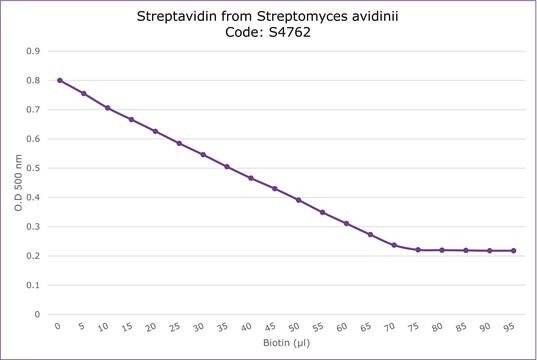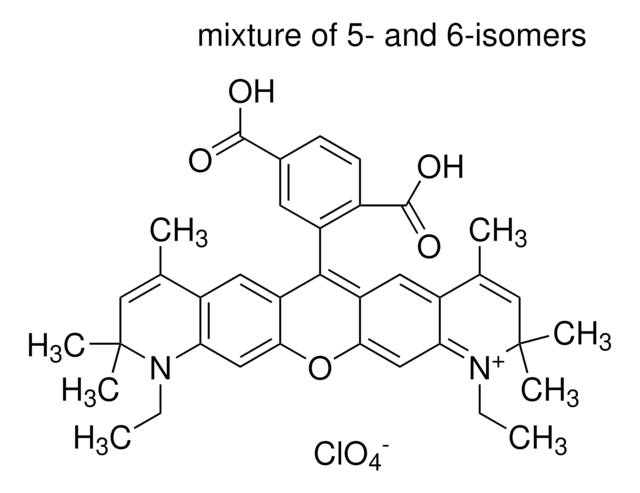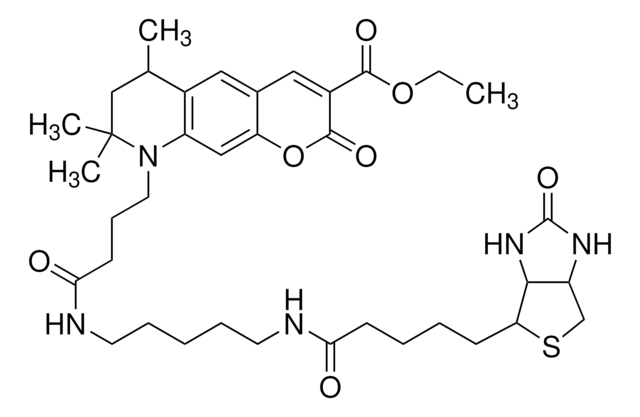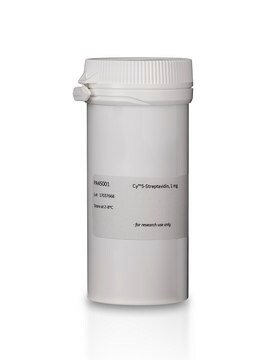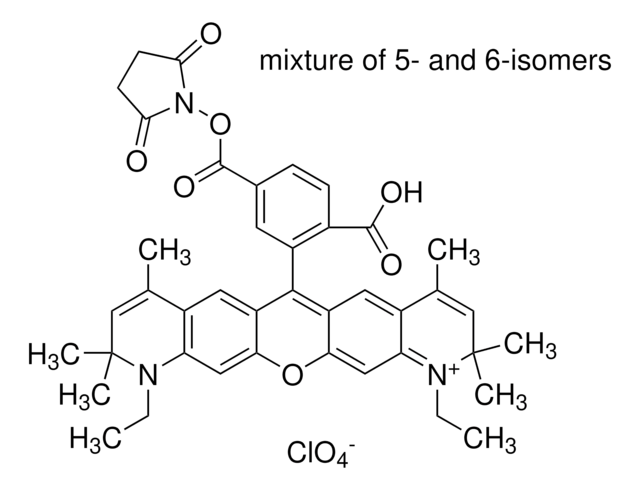43208
Atto 590-Biotin
BioReagent, suitable for fluorescence, ≥90.0% (HPLC)
Synonyme(s) :
Biotin-Atto 590
Se connecterpour consulter vos tarifs contractuels et ceux de votre entreprise/organisme
About This Item
Formule empirique (notation de Hill):
C52H65ClN6O10S
Poids moléculaire :
1001.62
Numéro MDL:
Code UNSPSC :
12352108
Nomenclature NACRES :
NA.32
Produits recommandés
Gamme de produits
BioReagent
Niveau de qualité
Essai
≥90.0% (HPLC)
Fabricant/nom de marque
ATTO-TEC GmbH
λ
in ethanol (with 0.1% trifluoroacetic acid)
Absorption UV
λ: 593-599 nm Amax
Adéquation
suitable for fluorescence
Température de stockage
−20°C
Application
Atto 590 is a new label with high molecular absorption (120.000) and quantum yield (0.80) as well as sufficient stoke′s shift (excitation maximum 594 nm, emission maximum 624 nm). Due to an insignificant triplet formation rate it is well suited for single molecule detection applications. Biotin conjugates can be used in applications like ELISA or immunohistochemistry, in situ hybridization, flow cytometry and others, to identify streptavidin, avidin, or extravidin-conjugates.
Informations légales
This product is for Research use only. In case of intended commercialization, please contact the IP-holder (ATTO-TEC GmbH, Germany) for licensing.
Vous ne trouvez pas le bon produit ?
Essayez notre Outil de sélection de produits.
Code de la classe de stockage
11 - Combustible Solids
Classe de danger pour l'eau (WGK)
WGK 3
Point d'éclair (°F)
Not applicable
Point d'éclair (°C)
Not applicable
Équipement de protection individuelle
Eyeshields, Gloves, type N95 (US)
Faites votre choix parmi les versions les plus récentes :
Déjà en possession de ce produit ?
Retrouvez la documentation relative aux produits que vous avez récemment achetés dans la Bibliothèque de documents.
Les clients ont également consulté
Shira Halivni et al.
ACS nano, 6(3), 2758-2765 (2012-02-09)
Fluorescence resonance energy transfer (FRET) involving a semiconductor nanoparticle (NP) acting as a donor, attached to multiple acceptors, is becoming a common tool for sensing, biolabeling, and energy transfer applications. Such nanosystems, with dimensions that are in the range of
Ronit Freeman et al.
Nano letters, 10(6), 2192-2196 (2010-05-21)
Semiconductor quantum dots (QDs) are used for the optical analysis of casein kinase (CK2) or the hydrolytic activity of alkaline phosphatase (ALP). Two schemes for the analysis of CK2 by a FRET-based mechanism are described. One approach involves the CK2-catalyzed
Andrea D Lehmann et al.
Small (Weinheim an der Bergstrasse, Germany), 6(6), 753-762 (2010-03-06)
Iron-platinum nanoparticles embedded in a poly(methacrylic acid) (PMA) polymer shell and fluorescently labeled with the dye ATTO 590 (FePt-PMA-ATTO-2%) are investigated in terms of their intracellular localization in lung cells and potential to induce a proinflammatory response dependent on concentration
Mariela M Marani et al.
Journal of combinatorial chemistry, 11(1), 146-150 (2008-12-17)
To screen one-bead-one-compound (OBOC) combinatorial libraries, tens of thousands to millions of compound beads are first mixed with a target molecule. The beads that interact with this molecule are then identified and isolated for compound structure determination. Here we describe
D Wildanger et al.
Journal of microscopy, 236(1), 35-43 (2009-09-24)
The advent of supercontinuum laser sources has enabled the implementation of compact and tunable stimulated emission depletion fluorescence microscopes for imaging far below the diffraction barrier. Here we report on an enhanced version of this approach displaying an all-physics based
Notre équipe de scientifiques dispose d'une expérience dans tous les secteurs de la recherche, notamment en sciences de la vie, science des matériaux, synthèse chimique, chromatographie, analyse et dans de nombreux autres domaines..
Contacter notre Service technique

